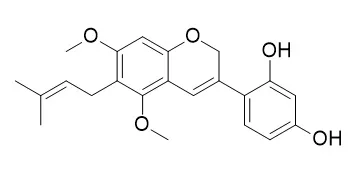| Description: |
Dehydroglyasperin D exhibits anticancer, anti-inflammatory, anti-obesity, antioxidant and anti-aldose reductase effects, it inhibits the proliferation of HT-29 human colorectal cancer cells through direct interaction with phosphatidylinositol 3-kinase; it also mediates suppression of both COX-2 expression and the MLK3 signalling pathway through direct binding and inhibition of MLK3. Dehydroglyasperin D shows strong ferric reducing activities and effectively scavenged DPPH, ABTS(+), and singlet oxygen radicals. |
| Targets: |
PI3K | Akt | GSK-3 | COX | PGE | AP-1 | JNK | p38MAPK | ROS |
| In vitro: |
| J Cancer Prev. 2016 Mar;21(1):26-31. | | Dehydroglyasperin D Inhibits the Proliferation of HT-29 Human Colorectal Cancer Cells Through Direct Interaction With Phosphatidylinositol 3-kinase.[Pubmed: 27051646] |
Despite recent advances in therapy, colorectal cancer still has a grim prognosis. Although licorice has been used in East Asian traditional medicine, the molecular properties of its constituents including Dehydroglyasperin D (DHGA-D) remain unknown. We sought to evaluate the inhibitory effect of DHGA-D on colorectal cancer cell proliferation and identify the primary signaling molecule targeted by DHGA-D.
METHODS AND RESULTS:
We evaluated anchorage-dependent and -independent cell growth in HT-29 human colorectal adenocarcinoma cells. The target protein of DHGA-D was identified by Western blot analysis with a specific antibody, and direct interaction between DHGA-D and the target protein was confirmed by kinase and pull-down assays. Cell cycle analysis by flow cytometry and further Western blot analysis was performed to identify the signaling pathway involved.
DHGA-D significantly suppressed anchorage-dependent and -independent HT-29 colorectal cancer cell proliferation. DHGA-D directly suppressed phosphatidylinositol 3-kinase (PI3K) activity and subsequent Akt phosphorylation and bound to the p110 subunit of PI3K. DHGA-D also significantly induced G1 cell cycle arrest, together with the suppression of glycogen synthase kinase 3β and retinoblastoma phosphorylation and cyclin D1 expression.
CONCLUSIONS:
DHGA-D has potent anticancer activity and targets PI3K in human colorectal adenocarcinoma HT-29 cells. To our knowledge, this is the first report to detail the molecular basis of DHGA-D in suppressing colorectal cancer cell growth. | | Nutr Res Pract. 2012 Dec;6(6):491-8. | | Antioxidant activities of licorice-derived prenylflavonoids.[Pubmed: 23346298] | Glycyrrhiza uralensis (or licorice) is a widely used Oriental herbal medicine from which the phenylflavonoids dehydroglyasperin C (DGC), Dehydroglyasperin D (DGD), and isoangustone A (IsoA) are derived. The purpose of the present study was to evaluate the antioxidant properties of DGC, DGD, and IsoA.
METHODS AND RESULTS:
The three compounds showed strong ferric reducing activities and effectively scavenged DPPH, ABTS(+), and singlet oxygen radicals. Among the three compounds tested, DGC showed the highest free radical scavenging capacity in human hepatoma HepG2 cells as assessed by oxidant-sensitive fluorescent dyes dichlorofluorescein diacetate and dihydroethidium bromide. In addition, all three compounds effectively suppressed lipid peroxidation in rat tissues as well as H(2)O(2)-induced ROS production in hepatoma cells.
CONCLUSIONS:
This study demonstrates that among the three phenylflavonoids isolated from licorice, DGC possesses the most potent antioxidant activity, suggesting it has protective effects against chronic diseases caused by reactive oxygen species as well as potential as an antioxidant food additive. |
|
| In vivo: |
| Biol Pharm Bull. 2010;33(5):917-21. | | Aldose reductase inhibitory compounds from Glycyrrhiza uralensis.[Pubmed: 20460778] | We evaluated the inhibitory effects of components from the root of Glycyrrhiza uralensis (G. uralensis) on aldose reductase (AR) and sorbitol formation in rat lenses with high levels of glucose as part of our ongoing search of natural sources for therapeutic and preventive agents for diabetic complications. In order to identify the bioactive components of G. uralensis, 5 prenylated flavonoids (semilicoisoflavone B, 7-O-methylluteone, dehydroglyasperin C, Dehydroglyasperin D, and isoangustone A), three flavonoids (liquiritigenin, isoliquiritigenin, and licochalcone A), and two triterpenoids (glycyrrhizin and glycyrrhetinic acid) were isolated; their chemical structures were then elucidated on the basis of spectroscopic evidence and comparison with published data.
METHODS AND RESULTS:
The anti-diabetic complication activities of 10 G. uralensis-derived components were investigated via inhibitory assays using rat lens AR (rAR) and human recombinant AR (rhAR). From the 10 isolated compounds, semilicoisoflavone B showed the most potent inhibition, with the IC(50) values of rAR and rhAR at 1.8 and 10.6microM, respectively. In the kinetic analyses using Lineweaver.Burk plots of 1/velocity and 1/concentration of substrate, semilicoisoflavone B showed noncompetitive inhibition against rhAR.
CONCLUSIONS:
The results clearly indicated that the presence of a gamma,gamma-dimethylchromene ring is partly responsible for the AR inhibitory activity of isoprenoid-type flavonoids. Further, semilicoisoflavone B inhibited sorbitol formation of rat lens incubated with a high concentration of glucose, indicating that this compound may be effective for preventing osmotic stress in hyperglycemia. |
|






 Cell. 2018 Jan 11;172(1-2):249-261.e12. doi: 10.1016/j.cell.2017.12.019.IF=36.216(2019)
Cell. 2018 Jan 11;172(1-2):249-261.e12. doi: 10.1016/j.cell.2017.12.019.IF=36.216(2019) Cell Metab. 2020 Mar 3;31(3):534-548.e5. doi: 10.1016/j.cmet.2020.01.002.IF=22.415(2019)
Cell Metab. 2020 Mar 3;31(3):534-548.e5. doi: 10.1016/j.cmet.2020.01.002.IF=22.415(2019) Mol Cell. 2017 Nov 16;68(4):673-685.e6. doi: 10.1016/j.molcel.2017.10.022.IF=14.548(2019)
Mol Cell. 2017 Nov 16;68(4):673-685.e6. doi: 10.1016/j.molcel.2017.10.022.IF=14.548(2019)